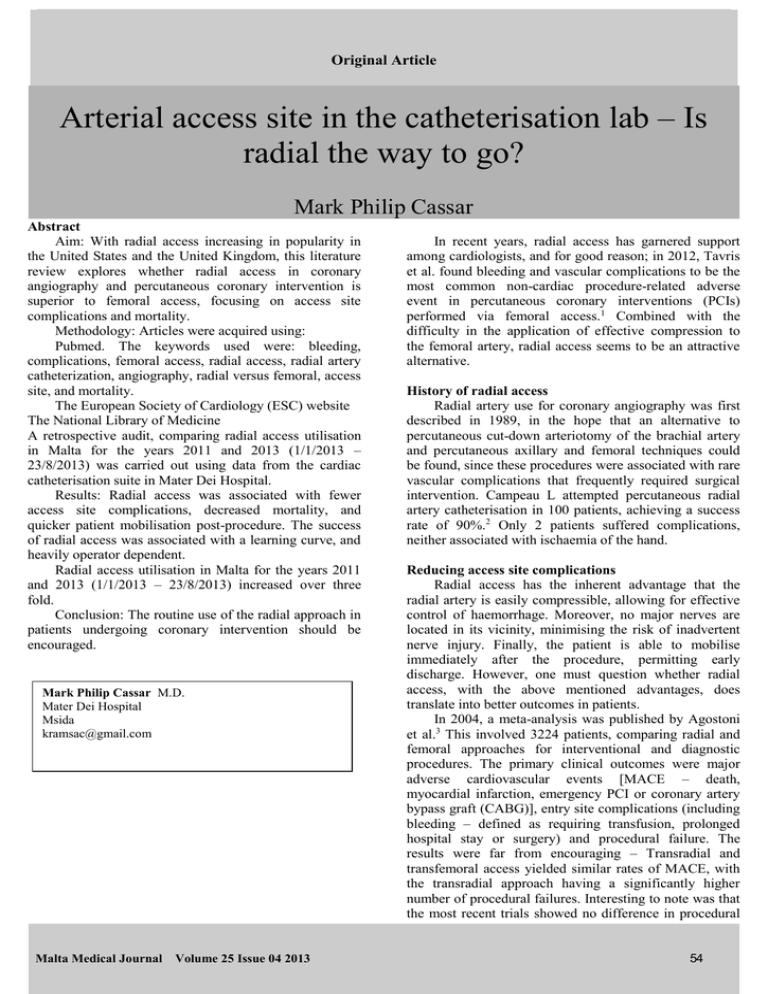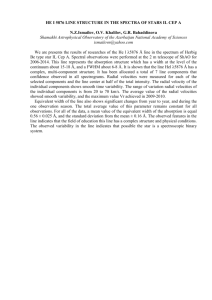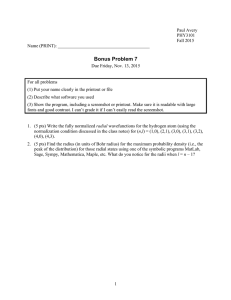Original Article
advertisement

Original Article Arterial access site in the catheterisation lab – Is radial the way to go? Mark Philip Cassar Abstract Aim: With radial access increasing in popularity in the United States and the United Kingdom, this literature review explores whether radial access in coronary angiography and percutaneous coronary intervention is superior to femoral access, focusing on access site complications and mortality. Methodology: Articles were acquired using: Pubmed. The keywords used were: bleeding, complications, femoral access, radial access, radial artery catheterization, angiography, radial versus femoral, access site, and mortality. The European Society of Cardiology (ESC) website The National Library of Medicine A retrospective audit, comparing radial access utilisation in Malta for the years 2011 and 2013 (1/1/2013 – 23/8/2013) was carried out using data from the cardiac catheterisation suite in Mater Dei Hospital. Results: Radial access was associated with fewer access site complications, decreased mortality, and quicker patient mobilisation post-procedure. The success of radial access was associated with a learning curve, and heavily operator dependent. Radial access utilisation in Malta for the years 2011 and 2013 (1/1/2013 – 23/8/2013) increased over three fold. Conclusion: The routine use of the radial approach in patients undergoing coronary intervention should be encouraged. Mark Philip Cassar M.D. Mater Dei Hospital Msida kramsac@gmail.com Malta Medical Journal Volume 25 Issue 04 2013 In recent years, radial access has garnered support among cardiologists, and for good reason; in 2012, Tavris et al. found bleeding and vascular complications to be the most common non-cardiac procedure-related adverse event in percutaneous coronary interventions (PCIs) performed via femoral access.1 Combined with the difficulty in the application of effective compression to the femoral artery, radial access seems to be an attractive alternative. History of radial access Radial artery use for coronary angiography was first described in 1989, in the hope that an alternative to percutaneous cut-down arteriotomy of the brachial artery and percutaneous axillary and femoral techniques could be found, since these procedures were associated with rare vascular complications that frequently required surgical intervention. Campeau L attempted percutaneous radial artery catheterisation in 100 patients, achieving a success rate of 90%.2 Only 2 patients suffered complications, neither associated with ischaemia of the hand. Reducing access site complications Radial access has the inherent advantage that the radial artery is easily compressible, allowing for effective control of haemorrhage. Moreover, no major nerves are located in its vicinity, minimising the risk of inadvertent nerve injury. Finally, the patient is able to mobilise immediately after the procedure, permitting early discharge. However, one must question whether radial access, with the above mentioned advantages, does translate into better outcomes in patients. In 2004, a meta-analysis was published by Agostoni et al.3 This involved 3224 patients, comparing radial and femoral approaches for interventional and diagnostic procedures. The primary clinical outcomes were major adverse cardiovascular events [MACE – death, myocardial infarction, emergency PCI or coronary artery bypass graft (CABG)], entry site complications (including bleeding – defined as requiring transfusion, prolonged hospital stay or surgery) and procedural failure. The results were far from encouraging – Transradial and transfemoral access yielded similar rates of MACE, with the transradial approach having a significantly higher number of procedural failures. Interesting to note was that the most recent trials showed no difference in procedural 54 Original Article failure between the two techniques, suggesting that operator skill plays a major role in the success rates of radial catheterisation.4,5 The transradial approach was, however, advantageous in virtually abolishing entry site complications (5 vs 32 in the femoral access group). The effect of bleeding on mortality In 2006, Eikelboom et al. published a data analysis of over 30,000 patients enrolled in the OASIS, OASIS-2 and CURE trials.6 The results showed that major bleeding in patients with acute coronary syndromes was associated with a 5 fold increase in the risk of death, remaining evident after adjustment for baseline characteristics. There was also an incremental relation between severity of bleeding and death. With radial access reducing access site complications, and the observed relationship between major bleeding and death, the next step was to investigate whether radial access reduced major bleeding and/or death. With 3,224 patients, the initial meta-analysis may have been underpowered to show a reduction in mortality in the radial arm. In 2008, results from two studies were published; the M.O.R.T.A.L retrospective study by Chase et al. looked at the relationship between transfusion requirements and access site choice,7 whilst Jolly et al. looked at the relationship between major bleeding (defined as fatal bleeding, intracranial haemorrhage, bleeding associated with ≥3 g/dL haemoglobin drop, or requiring transfusion or surgery) and access site, and whether decreased bleeding may be linked with fewer deaths and ischaemic events.8 In the M.O.R.T.A.L study, radial access halved the transfusion rate and was associated with a statistically significant reduction in 30-day and 1 year mortality. Jolly et al. only found a statistically significant reduction in major bleeding. Despite fewer occurrences in the radial access group for the composite of death, MI or stroke (2.5% vs 3.8%), statistical significance was not reached. The data did not favour radial access; procedural times were significantly longer, although there was significant heterogeneity, again suggesting operator experience being crucial in radial access. Radial access and mortality The M.O.R.T.A.L study, a retrospective analysis, could only propose a hypothesis of decreased mortality with radial access. The next stage of research was predictable: in 2011, the RIVAL study by Jolly et al. was published, comparing radial versus femoral access for coronary angiography and intervention;9 7,021 patients with ACS were randomly assigned to radial or femoral artery access. The primary outcome was a composite of death, MI, stroke, or non-CABG related bleeding at 30 days. Radial access did not significantly reduce the primary outcome, but significantly reduced vascular Malta Medical Journal Volume 25 Issue 04 2013 access complications compared with femoral access. Possible reasons cited for the absence a statistically significant reduction in non-CABG related major bleeding with radial access include: -Rigorous criteria for a complication to qualify as a major bleed (fatal/hypotension requiring inotropes/surgical intervention/severely disabling sequelae/intracranial or intraocular/Hb drop of at least 5 g/dL). Operators in RIVAL were high volume cardiologists (median PCI volume of 300/year), which may have led to the much lower observed risk of bleeding than anticipated in femoral artery access. Despite these limitations, sub-group analysis did show a significant decrease in the primary outcome in procedures performed by high volume operators (operators performing >142 radial PCIs per year), as well as a reduction in the secondary outcomes of death, myocardial infarction, stroke and overall mortality in patients with STEMI.9 This suggested that outcomes with radial access might be linked to expertise and operator volume, findings echoed in previous studies. In the setting of high volume operators and STEMI patients, would radial access be expected to deliver statistically significant results? In 2012, the RIFLE study addressed this question.10 1,001 acute STEMI patients were randomised to radial or femoral access, all treated at high volume centres, with less rigorous bleeding criteria than in RIVAL (any bleeding not related to CABG with 3g/dl decrease in Hb or more). The results were dramatic – radial access showed a significant lower incidence of death (43% lower mortality), together with a lower risk of access site bleeding and transfusion requirements. In contrast with previous studies showing prolonged procedural times, the RIFLE trial showed no differences in the symptom-toballoon and door-to-balloon times, attributable to operators being familiar with the procedure. Hospital stay was also shorter in the radial group (3 days vs 4 days). This, together with the reduced need for transfusions, may render radial access more attractive from the cost point of view. The push for radial access Responding to this mounting evidence, guidelines for the treatment of ST segment elevation myocardial infarction were published by the European Society of Cardiology in 2012,11 advocating radial in preference to femoral access for primary PCI, when performed by an experienced radial operator (class IIa, level B evidence). A position paper in 2013, published by the European Association of Percutaneous Cardiovascular Interventions and Working Groups on Acute Cardiac Care and Thrombosis of the European Society of Cardiology12 states: ‘Compared to femoral access, radial access has been shown to cause fewer complications at the vascular access site, allow more rapid ambulation, offer greater 55 Original Article postprocedural comfort for the patient and be cost effective’. A default radial approach was deemed feasible in routine practice. The latest and largest meta-analysis, published this year, included 29,194 STEMI patients undergoing primary angioplasty via radial or femoral approach.13 Radial access was associated with a significant reduction in mortality (5.2% vs 10.3%) and major bleeding (1.9% vs 4.7%). The conclusion encouraged routine use of radial approach in STEMI patients. Incidence in Malta With the mounting evidence favouring radial access, has its utilisation increased in Malta? A retrospective audit was carried out, using data obtained from the cardiac catheterisation suite at Mater Dei Hospital. The number of coronary angiograms and PCIs performed in 2011 and 2013 (1/1/2013 – 23/8/2013) were compared; the data was categorised according to the type of access site used. The following results were observed: Table 1: Table showing number of angiograms and PCIs performed in 2011 and 2013 (1/1/2013 – 23/8/2013) NUMBER OF PROCEDURES: 2011 1/1/2013 - 23/8/2013 Femoral Angiograms 2089 823 Radial Angiograms 192 300 Femoral PCIs 398 354 Radial PCIs 23 77 Figure 1: Graph showing number of angiograms and PCIs performed in 2011 and 2013 (1/1/2013 – 23/8/2013) according to access site. 30.00 References 1. 2. 3. 4. 17.87 20.00 Percentage, % Conclusion What does the future hold for radial access? The evidence is difficult to ignore; the radial approach is associated with reduced mortality, access site complications and hospital stay, with comparable door-toballoon times. Trials in progress will contribute further to our knowledge regarding radial access; the RADIAL-CABG trial16 will provide information about the role of radial access in bypass graft angiography and intervention, whilst the EXPERT trial17 will investigate whether experienced operators can perform angiography via both approaches with similar radiation exposure. In conclusion, the routine use of the radial approach in patients (both stable and unstable) should be strongly considered, bearing in mind the learning curve associated with the technique. Femoral access should, however, not be abandoned; when radial access is impossible, the groin is the way to go. 26.71 25.00 15.00 10.00 however leads the way, with >50% radial access utilisation in the year 2011.15 Radial Angiograms 8.42 5.46 Radial PCIs 5.00 5. 0.00 2011 1/1/2013 23/8/2013 Time period With the percentage of angiograms and PCIs done via radial access increasing more than 3 fold over the time period studied, the findings were very encouraging. Compared to other countries, Malta fared well; in the United States, the radial approach accounted for 16% of all PCI procedures in 2012.14 The United Kingdom Malta Medical Journal Volume 25 Issue 04 2013 6. 7. Tavris DR, Wang Y, Jacobs S, Gallauresi B, Curtis J, Messenger J, et al. Bleeding and vascular complications at the femoral access site following percutaneous coronary intervention (PCI): an evaluation of hemostasis strategies. The Journal of invasive cardiology. 2012;24(7):328-34. Epub 2012/07/12. Campeau L. Percutaneous radial artery approach for coronary angiography. Catheterization and cardiovascular diagnosis. 1989;16(1):3-7. Epub 1989/01/01. Agostoni P, Biondi-Zoccai GG, de Benedictis ML, Rigattieri S, Turri M, Anselmi M, et al. Radial versus femoral approach for percutaneous coronary diagnostic and interventional procedures; Systematic overview and meta-analysis of randomized trials. Journal of the American College of Cardiology. 2004;44(2):34956. Epub 2004/07/21. Saito S, Tanaka S, Hiroe Y, Miyashita Y, Takahashi S, Tanaka K, et al. Comparative study on transradial approach vs. transfemoral approach in primary stent implantation for patients with acute myocardial infarction: results of the test for myocardial infarction by prospective unicenter randomization for access sites (TEMPURA) trial. Catheterization and cardiovascular interventions : official journal of the Society for Cardiac Angiography & Interventions. 2003;59(1):26-33. Epub 2003/04/30. Louvard Y, Benamer H, Garot P, Hildick-Smith D, Loubeyre C, Rigattieri S, et al. Comparison of transradial and transfemoral approaches for coronary angiography and angioplasty in octogenarians (the OCTOPLUS study). The American journal of cardiology. 2004;94(9):1177-80. Epub 2004/11/03. Eikelboom JW, Mehta SR, Anand SS, Xie C, Fox KA, Yusuf S. Adverse impact of bleeding on prognosis in patients with acute coronary syndromes. Circulation. 2006;114(8):774-82. Epub 2006/08/16. Chase AJ, Fretz EB, Warburton WP, Klinke WP, Carere RG, Pi D, et al. Association of the arterial access site at angioplasty with transfusion and mortality: the M.O.R.T.A.L study (Mortality benefit Of Reduced Transfusion after percutaneous coronary intervention via the Arm or Leg). Heart. 2008;94(8):1019-25. Epub 2008/03/12. 56 Original Article 8. 9. 10. 11. 12. 13. 14. 15. 16. 17. Jolly SS, Amlani S, Hamon M, Yusuf S, Mehta SR. Radial versus femoral access for coronary angiography or intervention and the impact on major bleeding and ischemic events: a systematic review and meta-analysis of randomized trials. American heart journal. 2009;157(1):132-40. Epub 2008/12/17. Jolly SS, Yusuf S, Cairns J, Niemela K, Xavier D, Widimsky P, et al. Radial versus femoral access for coronary angiography and intervention in patients with acute coronary syndromes (RIVAL): a randomised, parallel group, multicentre trial. Lancet. 2011;377(9775):1409-20. Epub 2011/04/08. Romagnoli E, Biondi-Zoccai G, Sciahbasi A, Politi L, Rigattieri S, Pendenza G, et al. Radial versus femoral randomized investigation in ST-segment elevation acute coronary syndrome: the RIFLE-STEACS (Radial Versus Femoral Randomized Investigation in ST-Elevation Acute Coronary Syndrome) study. Journal of the American College of Cardiology. 2012;60(24):2481-9. Epub 2012/08/04. Steg PG, James SK, Atar D, Badano LP, Blomstrom-Lundqvist C, Borger MA, et al. ESC Guidelines for the management of acute myocardial infarction in patients presenting with STsegment elevation. European heart journal. 2012;33(20):2569619. Epub 2012/08/28. Hamon M, Pristipino C, Di Mario C, Nolan J, Ludwig J, Tubaro M, et al. Consensus document on the radial approach in percutaneous cardiovascular interventions: position paper by the European Association of Percutaneous Cardiovascular Interventions and Working Groups on Acute Cardiac Care and Thrombosis of the European Society of Cardiology. EuroIntervention : journal of EuroPCR in collaboration with the Working Group on Interventional Cardiology of the European Society of Cardiology. 2013. Epub 2013/01/29. De Luca G, Schaffer A, Wirianta J, Suryapranata H. Comprehensive meta-analysis of radial vs femoral approach in primary angioplasty for STEMI. International journal of cardiology. 2013. Epub 2013/03/16. Feldman DN, Swaminathan RV, Kaltenbach LA, Baklanov DV, Kim LK, Wong SC, et al. Adoption of radial access and comparison of outcomes to femoral access in percutaneous coronary intervention: an updated report from the national cardiovascular data registry (2007-2012). Circulation. 2013;127(23):2295-306. Ludman PF. National Audit of Percutaneous Coronary Interventional Procedures Public Report2013 14/08/2013 [cited 2013 14/08/2013]. Available from: http://www.ucl.ac.uk/nicor/audits/adultcardiacintervention/public reports/documents/pcireport2012. Brilakis Es. RADIAL Versus Femoral Access for Coronary Artery Bypass Graft Angiography and Intervention (RADIALCABG) Trial. [Internet] ClinicalTrials.gov: National Library of Medicine (US); 2013 [cited 2013 29/03/2013]; Available from: http://clinicaltrials.gov/ct2/show/record/NCT01446263. Moraes CV. Transradial and Transfemoral Coronary Angiography by EXPERienced operaTors (EXPERT). clinicaltrials.gov: National Library of Medicine (US); 2013 [cited 2013 28/03/2013]; Available from: http://www.clinicaltrials.gov/ct2/show/NCT01794325?term=radi al+access&rank=6. Malta Medical Journal Volume 25 Issue 04 2013 57





